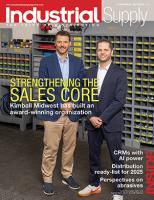Re-thinking the sales meeting

by Frank Hurtte
Are sales meetings producing the right kind of ROI for distributors? This is a tough question. But after observing hundreds of distributor sales meetings, I have my doubts. Considering the time, money and lost opportunity, these meetings must produce the right results.
I have yet to find a distributor that doesn’t have an event it calls a sales meeting. Naturally, and perhaps intuitively, a passing stranger without much experience in our world might come to the conclusion that these meetings are about sales. As a rule, they’re not. Instead, they have become an expensive company bulletin board, a tool for placating manufacturers bent on standing in front of a team and a forum for distraction.
If I was going to toss out the typical agenda for a distributor sales meeting it might look like this:
- 8:00 a.m. start time. There is much small talk as the group waits for people lumbering in 5, 10 or even 15 minutes late. While the idle chit chat serves the purpose of building comaraderie in the group, most of it has nothing to do with sales.
- Review of company numbers. This includes last month’s top-line and gross margin numbers. This information is often published elsewhere and, except for the occasional public congratulations, is difficult to justify in a post- internet world.
- Discussion of issues in other departments. The last meeting I attended contained a rambling and pointless negative exchange of warehouse-related war stories. A few of the stories extended back to mistakes made nearly five years ago. I wondered why any of these guys would continue to work for an organization with such terrible support problems.
- Manufacturer-led product/sales training. This was supposed to be the meat of the meeting, but mostly provided the team an opportunity to discretely check emails or catch up with friends on social media.
- Management wrap-up. Somehow I had hoped this would have at least included an overview of important issues facing distributors (like online business), a recap of their last DAC group or, at least, a hearty pep talk. It did not.
Thinking back, I didn’t see much value created. The two manufacturers were pleased they had access to the salespeople, but from the back of the room I could see the company’s best seller playing solitaire through most of the presentation. Honestly, my notes contained this phrase: “I just wasted an hour of my life.” It was that bad. Using a quick analysis, the whole thing cost my client well over three grand.
After that less than delightful experience, the thought of making these meetings into something valuable has been echoing through my brain. We’ll start with some basics, get more advanced and then push into some best-in-class benchmarks.
Sales meeting basics
For the sake of brevity and since you’ve probably seen them before, let me blast through these like Machine Gun Kelly.
- If there’s no reason for a meeting, don’t have one.
- Always have an agenda and make sure everyone knows what they need to do to prepare.
- Make the meetings mandatory and start the meeting on time. Salespeople will make the excuse, “I missed the meeting because I was closing a big order and couldn’t get away.” I knew one sales manager who instituted a policy; it was OK for a seller to miss a meeting but they forfeited $100 in commission. From that point, meetings were rarely missed.
- Preview or at least set expectations for manufacturer presentations. We’ll touch on this later.
- Insert a section on how to be a better seller; after all it is a sales meeting.
- Be prepared for your portion of the sales meeting. Winging it through the meeting sets the wrong example.
Be a more effective meeting planner
In the last issue of this publication, I made the following point: “Most managers make the mistake of thinking about their sales meetings as standalone events rather than an ongoing continuum.”
Here’s a best practice for developing killer meetings.
First, instead of just thinking about your next meeting, why not create a calendar of meetings for the year? This allows you to plan multiple meetings at once. You will never find yourself scrambling for meeting content the day before or, worse yet, winging it through a meeting that just managed to sneak up on you during a busy week. It minimizes the planning and creates better content at the same time.
Secondly, determine the important skills or behaviors you would like to develop in your team. For example, many companies struggle to develop CRM system participation. Many times this is tied to the will of the sales team to properly invest the time, for others it comes from a true lack of understanding of how and why CRM makes a difference. Either way, by devoting 15 minutes to internally developed best practices, the team makes progress. What’s more, this is a topic the sales manager can delegate to others on the team. The conversation might go like this, “Don, your contact list on the CRM system is far better than your peers, would you be willing to review your personal process for making this happen?” The following month you might ask one of your product specialists to outline how they use CRM-based opportunities to steer their efforts with various sellers.
The point is each meeting for the next several months (let’s say six) contains a brief agenda item tied to better use of your company’s CRM system. The repetition improves skills and reinforces your commitment to the process.
Manufacturer-based presentations
There are key supply partners and there are manufacturers whose products you sell mainly as an add-on service to your customers. One set is strategically important to your growth, the other group carries little if any potential for growth. Yet, I continue to see the unimportant group in front of the team and I have to ask why? Could this be due to last-minute decisions and opportunity to quickly fill a slot? Unfortunately, both groups of manufacturers are prone to miss the mark in their training.
A few years ago I led a networking group of sales VPs in the electrical wholesaling space. As we talked about manufacturer-provided training, one blurted, “Less than half of these give us what we need to be effective.” I thought he was just having a bad day but the room came alive with others questioning his numbers. They thought he was being generous; some put the number at less than 20 percent.
The problem with rep-driven presentations is they rarely focus on how to sell the product. While the fact that the manufacturer’s facility is state of the art is amazingly interesting, it doesn’t push the sales effort forward unless it translates into overnight shipping of every special order. Pushing forward to the ever present display of product features, without background on why these are important to customers, it just becomes useless mind clutter.
What should be covered in a manufacturer presentation? Here is a checklist:
- Specifically what kinds of customers would be attracted to the product and why?
- Who at the customer would most likely recognize the value? For instance, this is a product that safety managers will appreciate.
- What features differentiate the product from the competitors? This list could even include things like faster delivery or lower unit prices.
- If other distributors carry the product (and it happens), who are they and why does this product still make sense for the audience?
- What is the best way to demonstrate the product for best results? A role-play presentation is not a bad thing.
- What sales collateral is available to make sales calls most effective?
While none of these points should come as a surprise to selling professionals, it is amazing how many manufacturer sales types completely miss the point. Stepping further into the obvious, doing a sales presentation without the ability to immediately provide the right literature, demos or samples needed for a successful sales call is a waste of time. Studies indicate that adult retention levels fall off by 80 percent the week following any presentation. When literature and supplies dribble in over the next two to four weeks, many of the salient points of the presentation are lost. Busy salespeople never quite get around to taking the product to the customer. The time spent swirls down the proverbial drain.
Best practices in the world of product training calls for two things: materials instantly available and a targeting effort with the sellers attending. The best manufacturer people stick around after the training to jointly develop the three to five accounts with the greatest opportunity for fast conversion or immediate action. Because it’s all about sales anyway, setting up joint calls within the next few days to further train and assist in getting a customer signed up works wonders in moving numbers forward.
Include sales skills review into your meeting
With the potential exception of some special occasion, distributor sales meetings are devoid of anything to do with actually improving sales skills. As a person who conducts distributor sales training and often keynotes these special occasions, allow me to provide a thought. Twenty minutes of well-thought out sales skill discussion at each of your sales meetings trumps an all-day session with a trainer. I don’t care if it’s me or if Dale Carnegie himself returns from the dead and shows up at your meeting, my opinion holds.
Where does a busy sales manager get materials for this kind of training? The simple answer is there is no reason to reinvent the wheel. As a matter of fact, the Industrial Supply website has a special section loaded with great stuff to bring to your team. For example, Dave Kahle, who in my mind is the living legend in distributor sales training, published an article called “Nine Tips for Dealing With Angry and Difficult Customers.” Why wait until after your next upset customer to think about this issue with your team? Instead, bring this article to your next meeting and spend 15 minutes sharing thoughts on the topic.
Finally, a bit of a self-serving example. My latest book “Plan on Breaking Through: Customer-based Strategic Planning” comes with a set of discussion topics at the end of each chapter. These time-tested points will systematically help your team focus on the right stuff at the right customers. It’s designed to exactly fill this void.
The point of all this?
How much does it cost to pull your team off the road for a sales meeting? Considering just the easy stuff, even small distributors are investing significant money to the effort. Take exactly one minute and write down the things you could do to improve your meetings. If one of your actions is to get Frank’s book, it’s on Amazon.
 Frank Hurtte’s new book, “Plan on Breaking Through: Customer-based Strategic Planning,” lays down a road map for distributors in building stronger and more profitable sales. Contact him at River Heights Consulting at frank@riverheightsconsulting.com, (563) 514-1104 or visit
Frank Hurtte’s new book, “Plan on Breaking Through: Customer-based Strategic Planning,” lays down a road map for distributors in building stronger and more profitable sales. Contact him at River Heights Consulting at frank@riverheightsconsulting.com, (563) 514-1104 or visit
riverheightsconsulting.com.
This article originally appeared in the March/April 2018 issue of Industrial Supply magazine. Copyright 2018, Direct Business Media.











